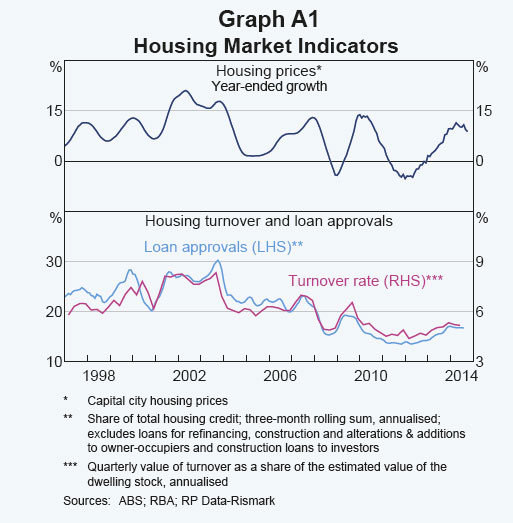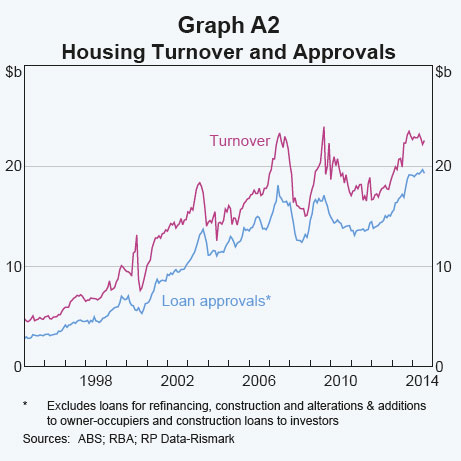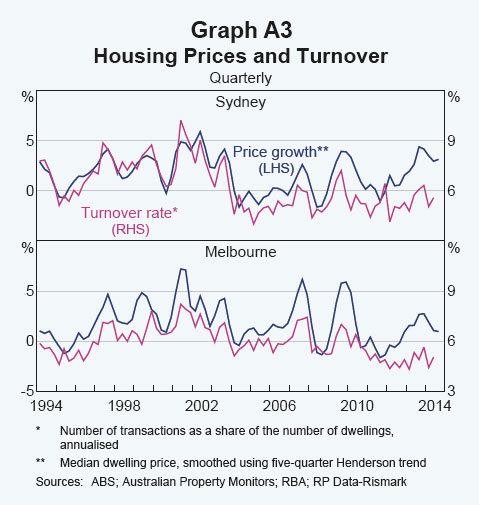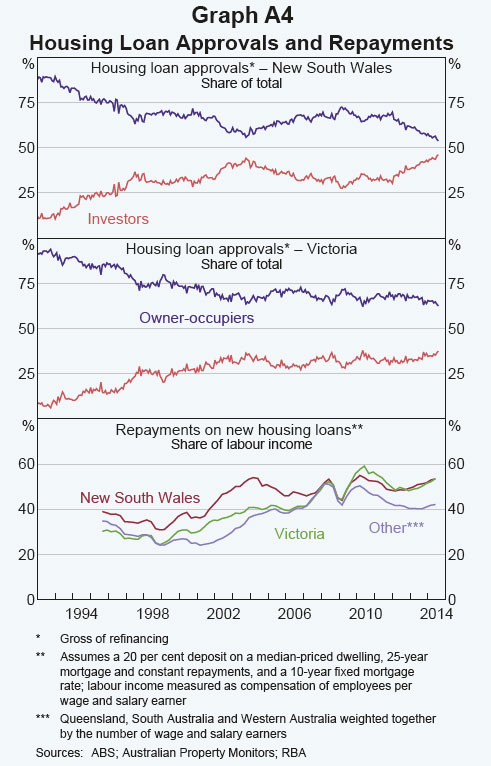The RBA, in today’s monetary statement discusses the relationship between loan growth and house prices. They conclude that factors including fear of unemployment, low supply, high loan to income ratios and stamp duty are all contributing factors, as well as price hikes themselves.
Indicators of conditions in the established housing market, such as housing prices, housing turnover and new borrowing, are interrelated and often move together quite closely (Graph A1). However, in recent years, housing turnover and loan approvals have risen by less than housing prices when compared with previous cycles in the housing market.
Turnover and loan approvals are closely linked. Each new housing loan represents a new transaction in the housing market (as long as it is not used to refinance an existing property or construct a new dwelling). Hence, the value of new borrowing will grow at about the same rate as the value of turnover as long as the average loan-to-valuation ratio does not change too much. In Australia, it turns out that the relationship between new borrowing and turnover has been quite stable for the past decade or so (Graph A2).
Housing prices and turnover might move together over time for a number of reasons, although the relationship may not be quite as tight as that between turnover and loan approvals (and it is possible for prices to rise with only limited turnover). One strand of research has found that an increase in housing prices causes an increase in turnover because higher housing prices increase the net wealth of homeowners. This allows those owners who did not previously have a large enough deposit to trade up to a more expensive dwelling, thereby increasing turnover. A complementary strand of research has found that the causality can also run in the other direction, from turnover to housing prices.
It suggests that some vendors might discern a rise in housing demand by observing a rise in turnover, thereby encouraging them to raise their reserve prices.
Turnover and housing price growth have moved together over time, although the relationship appears to have weakened somewhat in recent years. The change is most evident in Sydney and Melbourne, where growth in housing prices has been strongest of late (Graph A3). The rate of turnover has remained low in those cities, both in terms of their longer-term averages and relative to growth in housing prices.
It is difficult to know why the turnover rate has remained relatively low compared with its history and compared with prices. There is tentative evidence to suggest that existing homeowners have become more reluctant to borrow against increases in their net wealth to trade up homes. For example, the survey of Household Income and Labour Dynamics in Australia (HILDA) suggests that in 2011 and 2012 (the two most recent survey years) a smaller share of households bought larger homes than in any of the previous nine survey years. Also, there has been unusually low participation of owner-occupiers in housing market transactions recently (Graph A4). The reasons are not clear, although it partly reflects the fact that state government incentives for first home buyers have been redirected away from established dwellings towards new dwellings.
One possibility is that a reluctance to trade up homes reflects households generally becoming less willing to take on additional debt in recent years. Following the increase in leverage over the 1990s and early 2000s, the debt-to-income ratio has been stable at high levels. Although interest rates are currently low, the expected repayment burden on loans is at 10-year average levels, when calculated using a longer term interest rate to account for the expectation that variable interest rates will move up over time. Indeed, in New South Wales and Victoria, which have experienced the greatest disparity between housing prices and turnover relative to historical norms, the share of current income required to service an average loan over the next 10 years is close to historical highs.
Another consideration is that homeowners may be less willing to borrow more because growth in labour income has slowed. Nominal labour income has grown at an average annual rate of 2.7 per cent over the past two years, compared with a decade average of 6.2 per cent. And the widespread expectation is that wage growth will remain subdued for a time. Moreover, the Westpac-Melbourne Institute survey suggests that the share of households expecting more unemployment a year ahead has been at above-average levels since late 2011, which is an unusually long time by the historical standards of the survey.
Repayment obligations, in combination with uncertainty about future labour income, are an important consideration for homeowners. According to liaison with banks, one consequence of this environment is that an increasing share of owner occupiers is opting for interest-only loans to increase repayment flexibility.
A reluctance to trade up homes might also stem from increases in effective stamp duty rates. In some states, including New South Wales and Victoria, the nominal housing price thresholds at which higher rates of stamp duty apply have not changed for a number of years. As housing prices have risen, more buyers have fallen into the higher stamp duty brackets, acting as a disincentive to purchase housing. In New South Wales, for instance, the stamp duty paid on a median-priced home has grown to around 25 per cent of annual disposable income per household, from close to 10 per cent in 1991.
Finally, the relationship between turnover and housing prices can be affected by developments in housing supply. Additions to the housing stock have been relatively low in some states over recent years, which would weigh on the rate of turnover as it is currently measured, while low supply relative to demand would also put upward pressure on prices.




